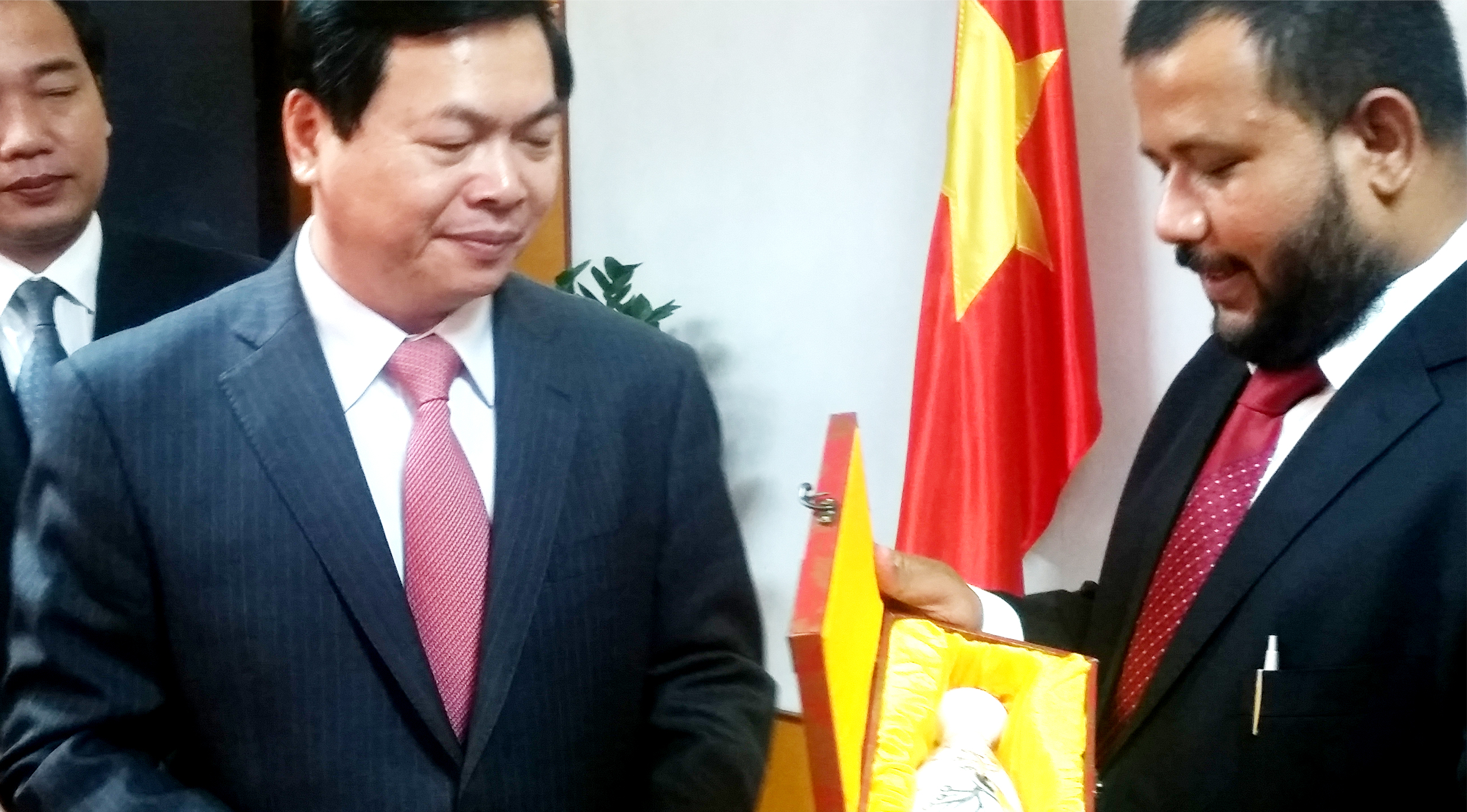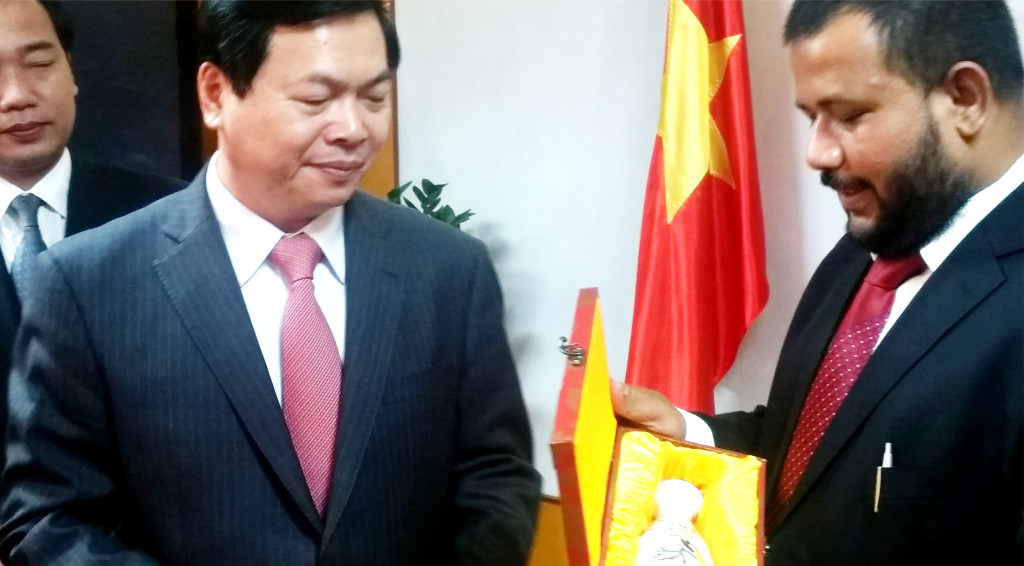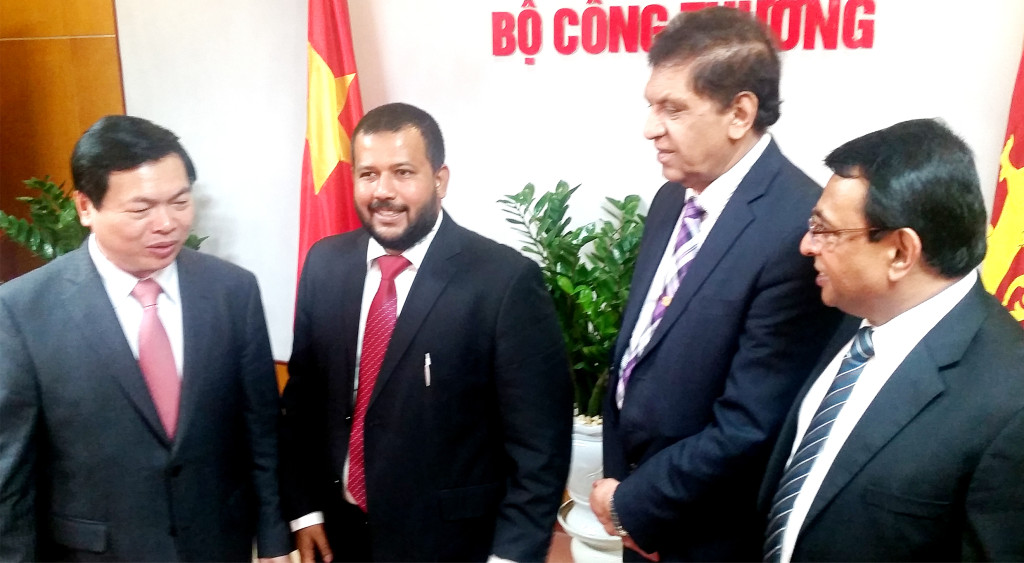- ‘Trade jumped by 88%!’-Rishad
- ‘Joint Com. way to study future PTA’-Vietnam’s Hoang
- ‘Will closely monitor progress!’-Rishad
- ‘Want to learn from your 5 Hubs’-Vietnam’s Hoang
The first ever Sri Lanka Vietnam official trade mechanism went live in Hanoi on 21 August. And the new mechanism, according to the Vietnamese side, is the practical way for bigger trade cooperation in the form of an Agreement. “Today’s new beginning will open many new opportunities for both countries. I am fully convinced that setting up of a Joint Working Group (JWG) or Joint Trade Sub Committee, would lay a concrete foundation to enhance the existing bilateral trade and economic relations new heights. My Ministry would closely monitor the progress” said a keen Rishad Bathiudeen (Minister of Industry and Commerce of Sri Lanka) at the Head Quarters of Ministry of Industry and Trade of Vietnam, Hanoi on 21 August.
Minister Bathiudeen, who made an in-depth and lengthy submission, was addressing the opening session of the bilateral discussions to establish the first Joint Trade Sub Committee (JTSC) between the two countries, held at the Head Quarters of Ministry of Industry and Trade of Vietnam, Hoan Kiem District, Hanoi on 21 August.
A six member team led by Minister Bathiudeen is currently in Hanoi for the talks to setup this first official trade mechanism. Along with Minister Bathiudeen in the delegation are RDS Kumararatne (DG-Department of Commerce), and Bandula Egodage (Chairman & CEO-EDB). Also joining the Sri Lankan team is (HE) Ivan Amarasinghe (Sri Lanka’s Ambassador to Vietnam). The seven member Vietnamese official delegation is led by the powerful Minister of Trade and Industry of the Vietnam (HE) Vu Huy Hoang and joined by his top commanders-Nuuyen Phuc Nam (Head of Western Asia Markets), and Qui Hui Son (DG-Vietnam Trade Promotion) as well as Deputy Directors. RDS Kumararatne (DG-Department of Commerce) is leading the technical sessions of the first JTSC in Hanoi.
“We commend and highly appreciate Sri Lanka’s efforts on economic and social development strategies-in that povery alleviation and economic development in the short period after the end of war. We greatly appreciate Lanka’s improvements in Human Development Index rankings, poverty reduction and international economic development as well as policies and direction of Sri Lanka’s economic development strategy under Mahinda Chinthana development framework. Vietnam in fact wants to learn from Sri Lanka about the five hub strategy. These are good lessons for us to apply for the social development of our country as well. Vietnam economy too, similar to Sri Lanka has faced difficulties due to global recession. Despite this Vietnam too managed to reconrd strong GDP growth-in 2013 at 5.32% and in the first seven months of 2014 at 5.5%. Our inflation which was at 6.2% in 2013 fell to a very low 1.45% in the first seven months of 2014! Our total international trade which stood at $ 266 Bn in 2013, expected to rise to $300 Bn. We have managed to bring our poverty household rate to 9% by 2013. Both Sri Lanka and Vietnam have lots of unrealised potential in joint economic cooperation and investments-in that the current trade volumes are modest and not in par with the strong bilateral cooperation that exists between both countries-and there is vast potential for new heights and lets work together. I request Sri Lanka Ministry of Industry and Commerce under Minister Bathiudeen to establish the Joint Sub Committee on Sri Lanka side and work with us. We take note of Sri Lanka’s proposal and engage relevant agencies in Vietnam to for this effort-both sides will continue their exchanges in this regard. The most practical way after establishing the JTSC is to study the possibility of establishing the Preferential Trade Agreement between both countries.”
At the 3rd Meeting of the Joint Commission held in Hanoi in July 2012, an ambitious target was set at for the total value of bilateral trade to reach US$ 01 Billion in the long term, commensurate with the decision taken by the two leaders during the visit of H.E. the President Mahinda Rajapaksa’s to Vietnam in October 2011 to Colombo. At present Vietnam ranks as the 40th export destination and the 23rd supplier, accounting for 0.43% of our total exports and 1.06% of our total imports respectively. The total trade between both countries which stood at US dollars 119.5 Million in 2012 increased to US dollars 224.4 Million in 2013 registering a remarkable growth of 88%. Since 2011, Petrovietnam Oil Corporation (PVOil) has supplied to its Sri Lankan partner with petroleum products. In the field of industry, the two countries have concluded a number of important documents, creating a legal framework for further enhanced cooperation activities. Those documents include: the MOU on Machinery Manufacturing Cooperation between the Ministry of Industry and Trade of Viet Nam and the Ministry of Industry and Commerce of Sri Lanka; the MOU on Oil and Gas Cooperation between the Ministry of Industry and Trade of Viet Nam and Ministry of Industry and Prime Minister’s Secretary Office of Sri Lanka.
As for Vietnam, it continues to integrate more deeply into the regional and global economy. Viet Nam is an active member of ASEAN, APEC, ASEM, WTO. In the framework of ASEAN, Viet Nam is party to ASEAN – China FTA, ASEAN – India FTA, ASEAN – Korea FTA, ASEAN – Australia – New Zealand FTA. Viet Nam is now negotiating FTAs with the EU; the Russia, Belarus and Kazakhstan Customs Union; EFTA; South Korea and the Trans Pacific Partnership Agreement (TPP). As regards foreign trade, Viet Nam’s export value reached USD 132.2 billion in 2013 (increased 15.4% as compared to 2012) and USD 83.5 billion in the first seven months of 2014 (increased more than 14% as compared to the same period of 2013). Viet Nam is among the world’s largest exporters of coffee, pepper, cashew nuts, rice, natural rubber. Viet Nam’s import value reached USD 131.3 billion (increased 15.4% as compared to 2012) and USD 82.2 billion in the first seven months of 2014 (increased 11.4% as compared to the same period of 2013). The state visit by H.E. President Mahinda Rajapaksa to Viet Nam in October 2009, the state visit by H.E. Truong Tan Sang, President of Viet Nam, to Sri Lanka in October 2011 and others have deepened the friendship between two countries, consolidated the mutual trust and understanding between the two countries.
“Today’s new beginning will open many new opportunities for both countries” said Minister Bathiudeen, addressing the session, and added: “Sri Lanka being a founder member of the GATT 1994, as well as WTO has been fully committed to liberal and market oriented Economic policies which aimed at achieving greater integration into the world economy. Sri Lanka has been an active participant in the Doha Development Agenda, having tabled, together with other countries, proposals on: technical barriers to trade; geographical indications; labelling of textiles, clothing, footwear, and travel goods; preferences erosion; and trade facilitation. Furthermore, Sri Lanka has been the pioneer in South Asia to introduce liberal and market oriented Economic policies as far back as in 1977. The country’s import regime has been liberalized; today 48% of total tariff lines are at Zero import duty, which is higher than that of the EU: Export control measures were eliminated; Foreign exchange regulations have been relaxed, thereby creating a business friendly environment. These initiatives and consistency in our economic policies under able leadership of His Excellency Mahinda Rajapaksa, the President of Sri Lanka with his vision for the future under “Mahinda Chinthana” have brought Sri Lanka much closer with the global partners and in particular, with the countries in Asia. The end to the prolonged internal conflict in 2009 and the restoration of peace and normalcy has created a greater optimism about the achievement of economic prosperity, providing a strong basis for long-term sustainable development supported by appropriate policies. “Mahinda Chintana”, the Government’s Ten Year Horizon Development Framework 2006-2016 was introduced with the objective of raising the GDP Growth to a rate exceeding 8%, per annum through investment in large scale infrastructure and the knowledge economy, and focus on rural development to help lagging regions. The strategy is seen with the commencement of the infrastructure development of Sri Lanka in the fields of ports, roads and highways, power, public utilities, arts and culture. The “Mahinda Chintana” identifies international trade as one of the significant macroeconomic instruments to achieve the country’s development goals. It envisages closer integration of trade promotion in the national development framework by further rationalization of trade and tariff policies, facilitation of a fair trading environment and encouragement of investment. The trade objectives within “Mahinda Chintana” also focus on increasing integration of the Sri Lankan economy with global markets. In the post-conflict economy, Sri Lanka recorded many important milestones. Per capita income doubled to reach over US dollars 3,200 in a relatively short period, thereby elevating the country to an “emerging market economy” status; the economy grew to a robust US dollar 65 billion of GDP, from about US dollars 24 billion in 2004; Inflation was contained at single digits for more than four years; Poverty levels reduced to around 6 percent from about 15%; Unemployment reduced to less than 4 percent; The quality of infrastructure was enhanced to a level comparable with many emerging market economies; Foreign reserves were maintained at over 6 billion US dollars; The public debt was managed prudently so as to reduce the debt-to-GDP ratio from a high of 105 percent in 2003 to about 78 percent; An over 7% economic growth was achieved in successive years; Private foreign investment inflows into the government has exceeded US$ 7 billion; The Fiscal deficit was limited to 6.4% in 2013, from a high of 9.9% in 2009; The country’s Doing Business global rank has reached the 81st level, up from 102nd in 2010, while being poised to jump about 10 places this year; Regional development has made tangible progress and the Western Province share of GDP reduced to around 43% from 51% in 2005; Regular foreign investment has flowed into banks and the stock market; The banking system was maintained in a stable condition even in the midst of very difficult global circumstances. Services sector was the major contributor to the economy, accounting for 51.3% of the total GDP in the year 2013 whereas; Industry and agricultural sectors contributed 41.5% and 7.2% of the total GDP respectively. The latest IMF assessment has given a glowing tribute to Sri Lanka’s economic performance. Its July 29th statement says: “Sri Lanka’s economic growth has been one of the fastest among Asia’s developing economies in recent years. After falling to 6.3 percent in 2012, real GDP growth accelerated to 7.3 percent in 2013-driven primarily by a pickup in services activity and supported by manufacturing and construction, but also benefiting from an increase in net exports”. IMF report further says that the inflation has remained low, falling to 4.7 per cent at the end of 2013 and to 3.2 per cent year-on-year in May 2014. Fiscal consolidation has continued, with the overall fiscal deficit falling to 5.9 per cent of GDP in 2013. A strong recovery in exports in the second half of 2013 and into 2014, combined with declining imports and continued inflow of remittances and services receipts, has bolstered the balance of payments. Together with issuance of external debt, this has allowed the Central Bank of Sri Lanka to accumulate international reserves. Monetary policy has been accommodative. High degree of openness to international trade, investor friendly atmosphere, and encouragement of foreign direct investment, among others, reflect the country’s commitment to the establishment of an environment conducive to private sector business development. Similarly, the achievements in terms of human capabilities have placed Sri Lanka at a higher rank, in the Human Development Index (HDI), vis-a-vis her South Asian neighbours. Sri Lanka is also on track of achieving time bound targets of the Millennium Development Goals (MDGs) which the United Nations member states agreed to achieve by the year 2015. Sri Lanka’s strategic location as a connecting point of sea and air transport between east and west has been complimentary to the expansion in the trade with the world. The Free Trade Agreements that Sri Lanka entered into with India (year 2000) and with Pakistan (year 2005) have already become the gateways for the manufacturers and investors in Sri Lanka in accessing the sub-regional market with over 1.6 billion people. Sri Lanka’s strategic location, skilled labour force, business infrastructure, common law based legal system, highly modernized sea port operations, recreational facilities and living standards have provided many opportunities for foreign investments. Apart from the above, one of the promising sectors for investment in Sri Lanka is Tourism. The tourism sector started booming with the dawn of the comprehensive peace in May 2009. We expect to cater to 2.5 million tourist s by 2016. Sri Lanka is progressing towards becoming South Asia’s Economic nucleus, through developing 05 hubs namely Aviation, Commercial, Maritime, Energy and Knowledge. In the realm of bilateral relations, Sri Lanka and Vietnam have been enjoying warm and cordial relations over a long period of years and it has been steadily developed based on mutual respect and shared values. In this context, I am pleased to observe that the trade volume between Sri Lanka and Vietnam has been growing at a steady pace in recent years. The total trade between both countries which stood at US dollars 119.5 Million in 2012 increased to US dollars 224.4 Million in 2013 registering a remarkable growth of 88%. These facts signify that there is huge, unrealized trade potential between two countries that we jointly need to exploit. However, there is no mechanism in place between the two countries at the government level, at present, aimed at strengthening existing bilateral trade and commercial relations. I am glad to learn about growth in the Vietnam Economy and in particular the growth in the industrial and high tech sectors. I am also confident that both countries would find many business opportunities which may be complementary to each other. (H.E)Ton Sinh Thanh, the Vietnamese Ambassador who just returned to your country after his term in Sri Lanka, has been instrumental in further strengthening relations between our two countries. He recently opened a Vietnam Trade Center in Colombo. He is also of the view that possible Free Trade Agreement between the two countries would help to further improve the trade and economic relations. In this context, I am fully convinced that setting up of a Joint Working Group (JWG) or Joint Trade Sub Committee, comprising senior officials from the two countries would lay a concrete foundation to enhance the existing bilateral trade and economic relations new heights. I have no doubts that the deliberations of our technocrats would finalize modalities of the Joint Working Group. My Ministry would closely monitor the progress towards enhanced trade, investment and economic cooperation between our two countries. I am therefore, confident that we may jointly be able to create a trade facilitating environment towards this objective.”


